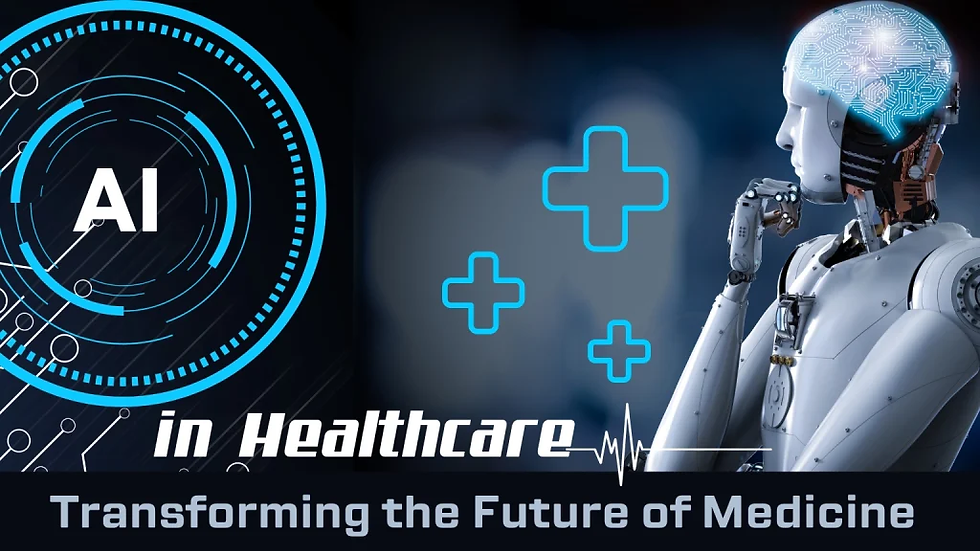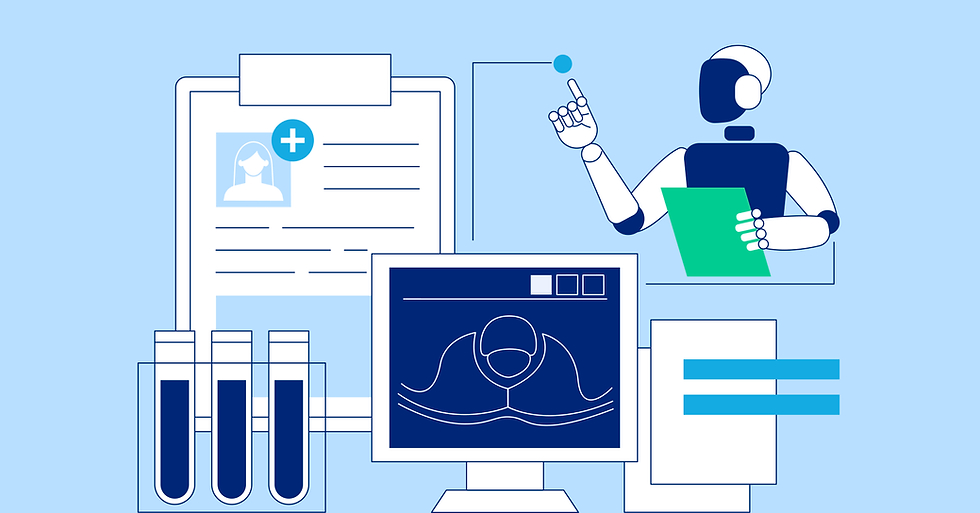How AI Can Forecast Your Future Health: The Revolution of Predictive Health Models
- Aisha Washington

- Oct 2
- 6 min read

Introduction
Artificial Intelligence (AI) is no longer limited to science fiction or simple automation—it is rapidly transforming the very foundation of healthcare. Imagine a future where doctors and patients can anticipate health risks years before symptoms appear, just as we rely on weather forecasts to plan our days. Today, cutting-edge AI models can sift through millions of medical records, identify subtle patterns, and forecast your likelihood of developing over 1,000 diseases. This article explores the evolution, science, promise, and ethical questions surrounding AI-driven health prediction, illuminating what this groundbreaking technology means for patients, clinicians, and society at large.
What Exactly Is AI Health Forecasting?

Core Definition and Common Misconceptions
AI health forecasting refers to the use of advanced artificial intelligence systems that analyze large datasets of medical records to predict an individual's risk of developing various diseases in the future. Unlike traditional risk calculators that focus on a handful of conditions, modern AI models like Delphi-2M are trained on vast, anonymized datasets—including hospital admissions, general practitioner (GP) records, and lifestyle data—to estimate the chances of developing more than a thousand different diseases.
Common Misconceptions:
It's Not Fortune-Telling: AI health forecasting does not provide specific predictions such as "You will have a heart attack on October 1." Instead, it offers probabilistic forecasts—much like weather reports—such as a 70% chance of developing type 2 diabetes within a certain period.
Not Limited to a Single Disease: These models can forecast risks across multiple diseases simultaneously, which has never been possible at this scale with traditional approaches.
Still Under Development: Despite the excitement, tools like Delphi-2M are not yet available for routine clinical use; they require further testing and rigorous regulation before wide adoption.
Why Is AI Health Forecasting So Important?

Its Impact and Value
AI-powered health forecasting has the potential to fundamentally reshape preventive medicine, patient care, and healthcare system management.
Disease Prevention and Early Intervention:
By identifying individuals at high risk for specific conditions, healthcare providers can offer targeted interventions—such as medication, lifestyle modifications, or increased screenings—long before disease develops. For example, if the system detects a heightened risk of liver disorders, patients could receive early counseling on alcohol consumption.
Healthcare Resource Planning:
AI models can aggregate data across entire populations to forecast the demand for medical services, helping hospitals and health systems prepare for future needs (e.g., estimating the number of heart attacks in a specific city years ahead).
Personalization and Equity in Care:
With the ability to process individualized risk profiles, AI forecasting may eventually help tailor prevention and treatment strategies to each person—improving outcomes and making healthcare more efficient and equitable.
The Evolution of AI Health Forecasting: From Past to Present
The journey from basic risk calculators to sophisticated AI health models highlights a dramatic leap in technology:
Traditional Tools: Previous risk calculators were limited, often focusing on a few variables to estimate risk for conditions like heart disease or stroke (e.g., cholesterol calculators).
The Advent of Deep Learning: Modern AI systems use methods inspired by neural networks and "generative models." These techniques allow the analysis of enormous datasets and the detection of subtle, complex patterns unnoticeable to human doctors.
Scaling Up: Today's models, such as Delphi-2M, are trained on hundreds of thousands to millions of anonymized records, including diverse types of data: hospital admissions, GP visits, and lifestyle information.
International Validation: The latest generation of AI health models has been validated across different populations, such as in the UK and Denmark, demonstrating both accuracy and generalizability.
How AI Health Forecasting Works: A Step-by-Step Reveal

Let's break down how AI health forecasting models function, from data intake to actionable insights:
Step 1: Data Collection and Anonymization
AI models are built on massive datasets, such as the UK Biobank, which includes medical histories, hospital admissions, lifestyle factors, and more from over 400,000 individuals. Importantly, data is anonymized to protect patient privacy.
Step 2: Pattern Recognition
Using techniques similar to those behind AI chatbots, the system learns to "read" medical records, detecting relationships between past health events, current status, and potential future outcomes.
Step 3: Risk Estimation
For every individual, the model estimates the likelihood of developing any of more than 1,000 conditions—expressed as probabilities over specific timeframes. For example, "There is a one-in-10 chance you will develop type 2 diabetes next year."
Step 4: Real-World Testing
Predictions are validated against independent datasets to test their accuracy. For instance, when applied to 1.9 million records in Denmark, Delphi-2M's predicted risks closely matched the actual occurrence of disease.
Step 5: Clinical Integration (Planned)
Once accuracy and ethical concerns are addressed, AI forecasts could be provided to clinicians and patients for use in care planning, prevention, and population health management.
How to Apply AI Health Forecasting in Real Life
While AI health forecasting is not yet standard practice, its future applications are both broad and transformative:
Preventive Medicine: Individuals identified as high-risk can receive early interventions—ranging from tailored lifestyle advice to preventive medication—potentially reducing incidence and severity of chronic diseases.
Personal Health Awareness: As AI models become integrated into electronic health records, patients could have access to regularly updated forecasts, empowering them to make proactive health choices.
Population Health Management: Healthcare administrators can use aggregated predictions to plan services, allocate resources, and optimize screening programs, improving overall efficiency and outcomes.
Research and Development: Predictive models can help identify disease trends and potential outbreaks, guiding public health strategies and biomedical research.
The Future of AI Health Forecasting: Opportunities and Challenges

As promising as AI health forecasting appears, several hurdles and opportunities remain:
Opportunities:
Personalized Medicine: AI could enable healthcare that is truly personalized, with treatment and prevention plans tailored to each individual's risk profile.
Healthcare Efficiency: Anticipating demand may optimize resource use, reduce costs, and improve patient outcomes.
Expanding Data Horizons: New models are being trained on increasingly diverse types of data, including genetic, imaging, and blood analysis information, promising even more accurate forecasts.
Challenges:
Data Bias and Generalization: Models trained on limited demographics, such as middle-aged adults from the UK Biobank, may not generalize well to other groups. It is crucial to ensure diverse, representative training data.
Privacy and Ethics: Ensuring patient privacy, data security, and transparent algorithms is paramount for trust and broad adoption.
Clinical Integration: Rigorous testing, regulation, and oversight are required before AI health forecasting becomes routine in medical practice.
Interpretability: Both patients and doctors need clear, understandable explanations of AI predictions—not just "black box" probabilities.
Industry experts predict that, much like genomic medicine, it may take a decade or more for AI health forecasting to progress from laboratory confidence to daily clinical reality.
Conclusion: Key Takeaways on AI Health Forecasting
AI health forecasting is poised to revolutionize medicine—transforming how we predict, prevent, and manage disease. By leveraging vast medical data and sophisticated algorithms, tools like Delphi-2M can estimate the risk of over a thousand diseases, offering actionable insights to patients, providers, and health systems. However, widespread adoption will require rigorous validation, ethical safeguards, and thoughtful integration into existing care pathways. As this technology matures, it promises a future of more proactive, personalized, and effective healthcare for all.
Frequently Asked Questions (FAQ) about AI Health Forecasting

What is AI health forecasting?
AI health forecasting refers to the use of artificial intelligence systems that analyze large amounts of medical data to predict an individual's risk of developing various diseases in the future—similar to how weather forecasts estimate the likelihood of rain.
How accurate and practical are these AI health predictions?
Modern AI models, when validated on large datasets, show impressive accuracy in predicting diseases with clear progression, like type 2 diabetes and heart attacks. However, predictions are probabilistic, not absolute, and are most effective when combined with clinical judgment and follow-up testing.
How is AI health forecasting different from traditional risk calculators?
While traditional calculators usually assess risk for a limited number of conditions using a small set of variables, AI models can simultaneously estimate the likelihood of over 1,000 diseases using far more comprehensive data and sophisticated algorithms.
How can someone access or benefit from AI health forecasts?
Currently, AI health forecasting is still in the research phase and not yet available for routine use. When clinical integration occurs, patients will likely benefit through more personalized prevention plans and earlier intervention opportunities, as well as improved health system resource planning.
What are the main challenges and ethical issues with AI health forecasting?
Key challenges include potential data biases, the need for representative and diverse datasets, privacy and data security concerns, regulatory approval, and ensuring that AI predictions are transparent and easily understood by both doctors and patients.


